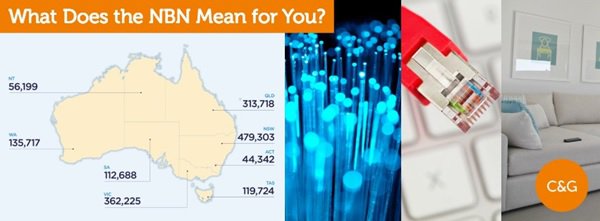What Does the NBN Mean for You? C&G Explains.
The National Broadband Network was first proposed by the Rudd Government in 2009, and has since been a point of national contention. The rollout is very real, however - and whether you’re a landlord, tenant or homeowner - C&G have summarised the key information you need to know about how the NBN affects you.
The National Broadband Network
It was April 2009 when Kevin Rudd (Australian Labour Party) decided to take the next step for Australia’s communications future, and announced that the government would establish a new company to build and operate a National Broadband Network. The project was initially budgeted at $43 billion over eight years, and the goal was set at improving internet speed for the entire population.
What are the different types of connections?
There are two main types of fibre-optic cables being laid for the NBN, affecting the speed and efficiency with which your home can be connected. Here’s how Optus describes them:
FTTP – Fibre to the Premises: reaches you via fibre-optic cable laid either in the ground or coming to your home via overhead lines.
FTTN – Fibre to the Node: copper wires from your home connect up to the new fibre network in your street.
Today, the rollout is well underway, and aims to replace copper phone lines with tubes of fibre that will allow for significantly faster internet connection speeds across Australia, with completion by 2021.

Why all the hype?
The broad range of key stakeholders (the Australian Government, Telstra, NBN Co. and shareholders) increases the diversity of opinions on the best way to streamline the rollout, making it cost effective and robust in the long term.
How will I know if I have it on my street?
As the rollout is a massive undertaking, there is no rigid schedule which will accurately predict when a property will have access to the NBN. However, residents and home owners can check their address using a quick search tool online, which can be found here. While you can register to be notified when the NBN is on your street, there are no ways to guarantee that the NBN will be available at any given time until the service is deemed available at that exact address. It’s a bit of a ‘chicken and egg’ situation.

Who is accountable for getting the NBN up and running at a property?
The rollout is the responsibility of the NBN Co., and setting up a service plan is the responsibility of the occupant, who can pick and choose a service provider just as they would with ADSL or wireless broadband.
The rollout is arranged at a property in four stages: planning, build preparation, build commenced, and service available. Once the final stage has been announced, residents or home owners can contact their internet service providers and purchase an NBN plan.
The NBN Co. does not sell directly to consumers (it’s a wholesale-only network), which is why the NBN plan must be purchased through a service provider like Optus or Telstra.
Standard installation of the fibre-optic cabling is currently covered by the government, but when it comes to connecting the modem, it is the occupant or tenant that will need to cover any costs. This is just as it would be with a new ADSL connection, and these costs will be charged by the internet service provider.
If you have the NBN on your street and would like more information, the best way to get informed on your specific circumstances is to contact your service provider.
